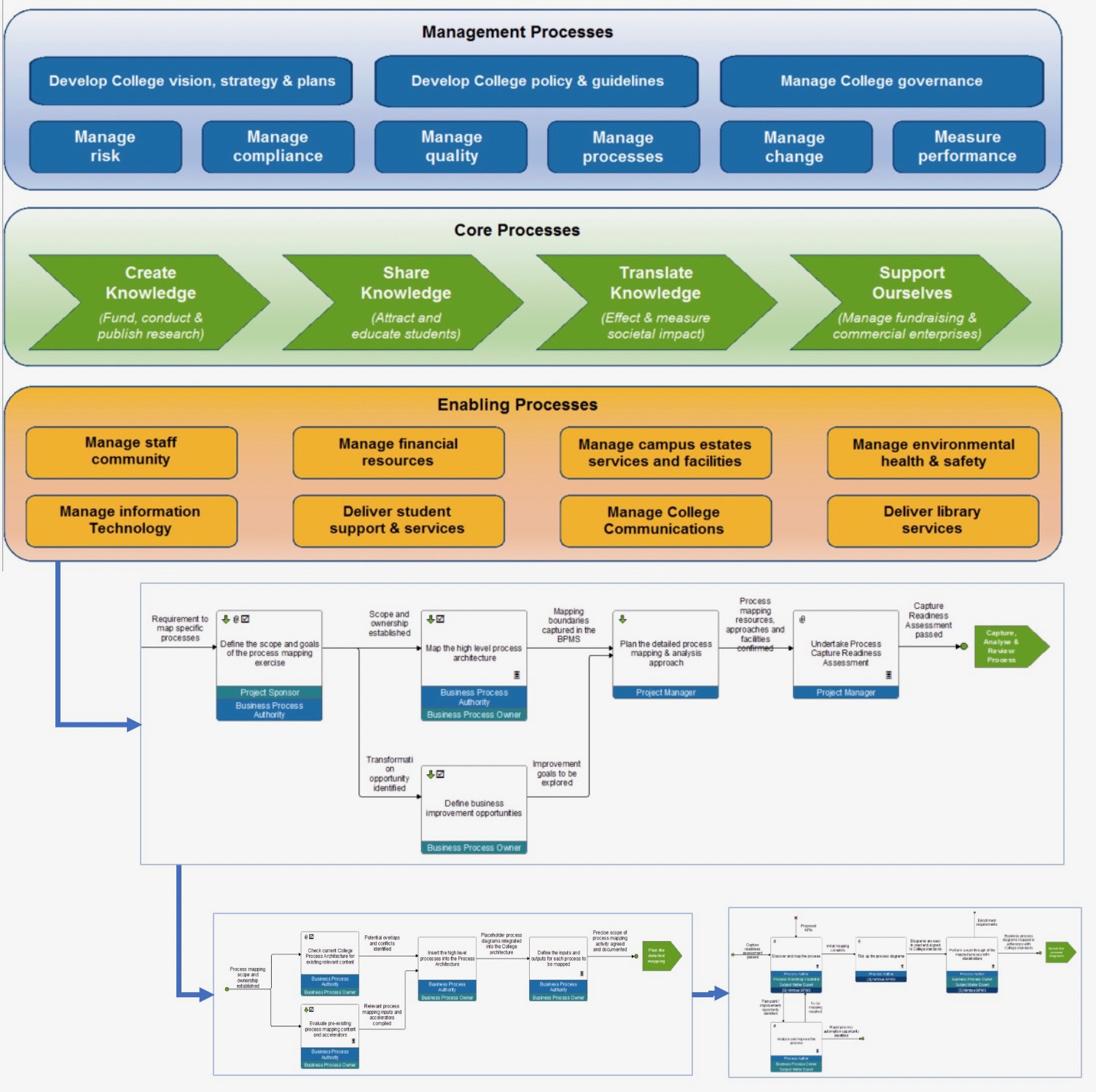Overview
Mapping the College’s Process Architecture enables us to understand, visualise and optimise our business processes from a perspective that is independent of organisational and functional siloes. By bringing our processes into a shared Business Process Management System (BPMS), we can present them visually, make them widely accessible in College and establish a shared understanding that supports innovation, automation and continuous improvement.
A key goal of our shared Process Architecture is transparency. The BPMS offers a single source of truth that enables us to navigate across end-to-end processes that span multiple organisational boundaries. We can drill to detail, to understand how each sub-process operates, who is involved and how it interfaces with other processes. Furthermore, we can see who owns a process, when it was last approved and what business rules, policies, frameworks or user guidance it must adhere to.
Processes mapped within our BPMS are accessible via a web browser and can be enriched with helpful materials and links, such as ‘how to’ guides, policies and templates, before being published to a wider College audience.

The curation, quality and governance of Imperial College’s Process Architecture is the responsibility of the Business Process Authority (BPA), Sue Flockhart, who works closely with Business Process Owners and Process Authors to develop and manage the content of the BPMS and to champion its usage in College.
Process Architecture
- Where is the College Process Architecture stored?
- Process ownership and governance at Imperial College
- Role of the Business Process Authority (BPA)
- Other Process-related roles
- Bringing processes into the Nimbus BPMS
The College has invested in a Business Process Management System (BPMS) named Nimbus, which brings College-wide process maps and supporting documentation into a single shared repository. The Nimbus BPMS is now the standard point of reference for College business processes.
Every process mapped within our BPMS is owned and approved by a Business Process Owner. This is the person responsible for the overall governance, execution and performance of the process, whose name will be displayed in the header information on any published maps and diagrams in the BPMS.
The Business Process Owner:
- Defines the scope and boundaries of the processes for which they are the owner
- Sponsors process mapping and improvement initiatives
- Provides Subject Matter Experts to participate in these initiatives
- Defines the governance and approval routes for process artefacts within the BPMS
- Resolves process overlaps, conflicts and variants, in partnership with the Business Process Authority
- Continuously reviews and improves the performance of their processes, in line with College strategy.
The Process Owner may delegate ownership of sub-processes that fall within their scope, whilst remaining responsible for the overall process. The Process Owner may also be supported by a Business Process Manager, who is responsible for the day-to-day running and performance of the process.
Process Architecture

The development, curation and governance of the College’s business Process Architecture is the responsibility of the Business Process Authority (BPA), Sue Flockhart. As custodian of the Business Process Management System (BPMS), the BPA guides the strategic direction of the shared repository and defines the framework and standards by which our Nimbus processes are discovered, analysed and mapped.
The BPA works in partnership with Business Process Owners to define the scope and boundaries of processes, to provide process-mapping skills and resources, to resolve conflicts, to resolve conflicts, and to ensure that processes mapped within our BPMS are of a high quality before being published to a wider College audience.
Process Authors are process mappers who are trained to capture processes within the Nimbus BPMS. This may include specialist roles (e.g. Business Analysts, Operational Improvement Specialists or external consultants) or any staff members in College with an interest in process mapping. The Process Author works with the Business Process Owner and Subject Matter Experts (SMEs) to discover processes and to create high quality business process maps and supporting documents within the BPMS.
Subject Matter Experts are people nominated by the Process Owner to provide expertise to support process mapping and improvement. The goal of the SME is to ensure that the business process is correctly understood, documented and designed in a way that is fit for purpose.
Process Owners can contact the BPA at any time to discuss the options for mapping processes within the Nimbus BPMS. Process mapping may be carried out as part of a change project or as part of ‘business as usual’. Process Owners are advised to engage the services of a skilled Process Author, to ensure that processes are discovered and capture to a high standard. To request access to a trained Nimbus Process Author, or to request Nimbus training for your own team members, contact the BPA (s.flockhart@imperial.ac.uk).
As an interim step, until all College processes are integrated into the College’s Nimbus Process Architecture, other process documentation (such as Visio maps, slides and other documents) can be made available in Nimbus as hyperlinks or attachments and integrated into the Nimbus maps. This way, we can make all of our process information accessible in one place as a single source of truth.
